Robert SCOTT was born on September 13, 1861, the eldest child of Thomas and Elizabeth (McCLENAGHAN) SCOTT. He was likely born in Ormstown, Canada, and was baptized Presbyterian in the Episcopal Church of England and Scotland, on November 21, 1861, in Salaberry-de-Valleyfield.[1] Ormstown is in Quebec, near the Ontario border. This part of Canada on the St. Lawrence River, in the Châteauguay River Valley, is about an hour downriver from Montreal and only 20 minutes north of the United States border at New York. It has been called the ‘Venice of Quebec’ due to the canals and rivers on which the towns are situated.[2] Ormstown itself was settled in the early 1800s by Scottish and Irish immigrants; Robert SCOTT’s parents were some of the original founders.[3]
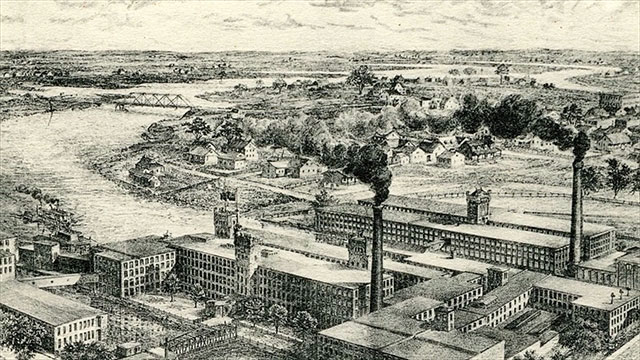
Thomas SCOTT was born in Scotland around 1820. Thomas was a miller by trade, and he immigrated sometime in 1847.[4] During this time Scotland and Ireland were suffering from famine and immigrants left by the thousands for Canada and America. The year that Thomas SCOTT arrived in Montreal was a record year for the number of immigrants coming into Quebec. Nearly 100,000 immigrants sailed for Quebec that year alone, 2 in 10 of those would die in the passage – cholera and typhus were common diseases brought with the new residents.[5] Thomas, however, arrived safe and healthy.
Around the time Thomas came to Canada railroad and canal expansion, coupled with increasing immigration from Europe due to economic hardships there, made Montréal a prominent economic city.[6] Within a few years of arriving in the city, Thomas made his way west toward Ontario to find work as a laborer.[7] He would return to marry and bring his bride west with him.
Thomas married Elizabeth McCLENAGHAN in Montréal in 1857 in St. Andrews Presbyterian Church.[8] Elizabeth was born in Quebec in 1833, the daughter of Irish immigrants. During her youth in Montreal she would witness the Great Fire of 1852, in which 10% of the eastern portion of the city was destroyed, the Cholera epidemic of 1854, and the building of the Notre-Dame-de-Grace.
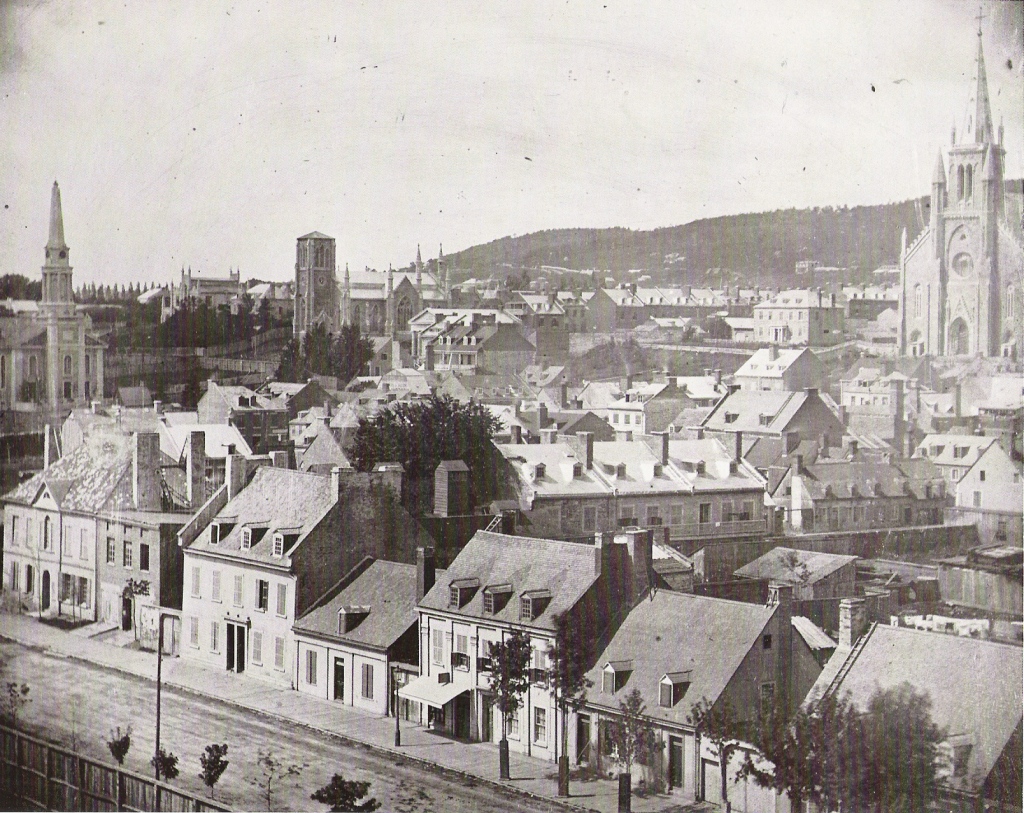
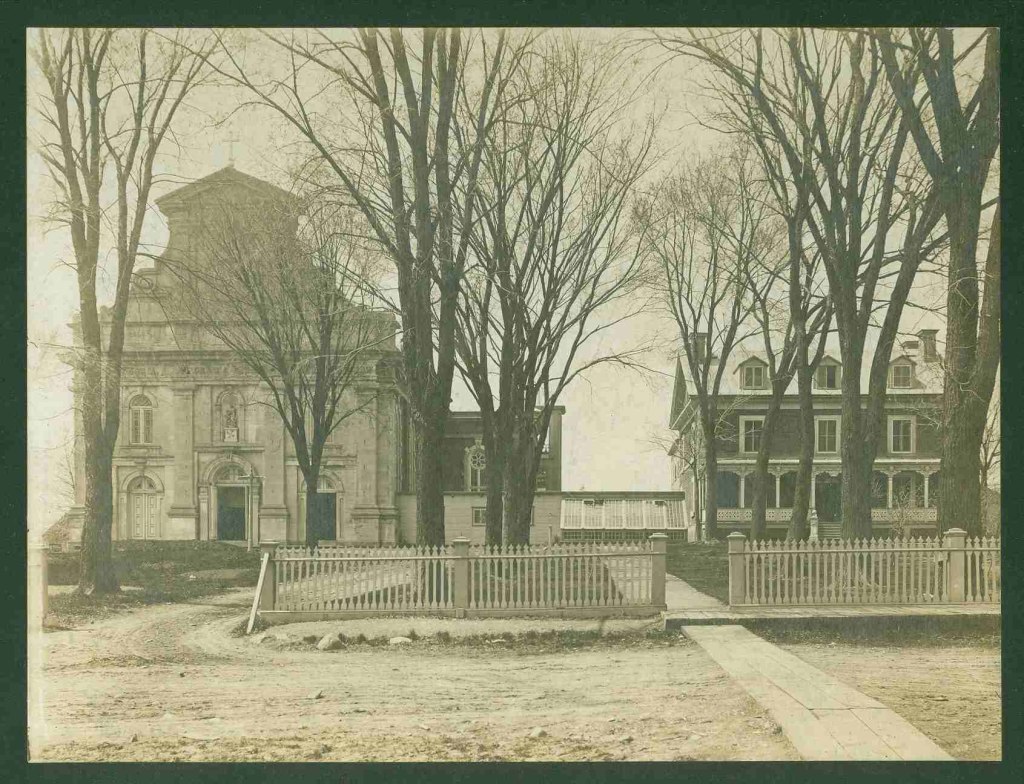
After the birth of their son, Thomas and Elizabeth had two daughters – Rebecca Jane (born in 1864) and Margaret Elizabeth (born in 1870).[9] The SCOTTs raised their children in Canada, first in Quebec just outside of Montreal, and then farther west in Durham, Ontario. Robert learned to become a miller, like his father.
In 1883, when he was 21 years old, Robert SCOTT emigrated to America.[10] Robert lived in Minneapolis and worked as a miller in the downtown area.[11] This was a time of growth and industry in Minneapolis – the Great Northern Railway from St. Paul to Seattle was built in 1883 and the Stone Arch Bridge was completed to take the railroad across the Mississippi River. To celebrate completion of the transcontinental line, the Twin Cities had a huge celebration attracting over 100,000 residents. Robert SCOTT would have arrived in the city just in time to celebrate and participate in the expansion of the city.

In Canada, in late May of 1886, Thomas SCOTT began to complain of chest pains. He died of heart disease on June 2. He was buried in Emily Presbyterian Cemetery in Kawartha Lakes, Ontario.[12]

Robert’s mother, Elizabeth, immigrated to the United States to be near her son shortly after her husband’s death, leaving her daughters in Canada. Rebecca Jane SCOTT married William MILLS, a young widower with three children, in early 1886 and together they had 6 kids: Lorne Lee Scott (b. 1887), Margaret (b. 1889), Robert Bruce (b. 1891), Frederick (b. 1894), Orville (b. 1899) and Lancelot Theodore (b. 1902).[13] Margaret never married – she worked as a cook, once in the home of noted barrister and Honorary Chief of the Six Nations Edward Marion Chadwick,[14] and also in the home of Sir George Burton, Chief Justice of Ontario prior to his death in 1901.[15] In the 1911 Census she is listed as a patient at the Toronto Home for Incurables.[16] The paper trail is lost after this point for the youngest SCOTT sibling.
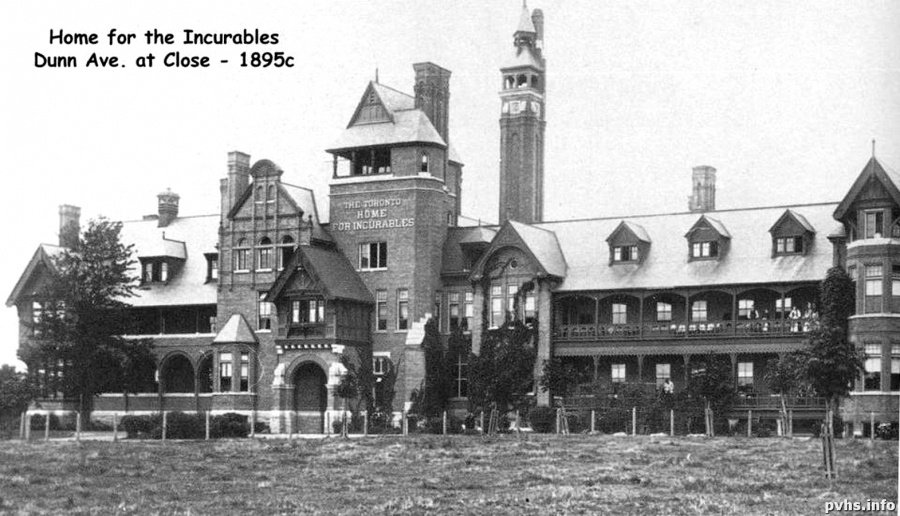
In Minneapolis, Robert SCOTT worked for Humboldt Mill on the St. Anthony Falls. The riverfront was lined with more than 20 stone flour mills, and the city held the title of “Flour Milling Capital of the World” for the latter part of the 19th and into the 20th Century.[17] The Humboldt Mill where Robert worked was called “a model of the “most advanced system of New Process Milling” and architectural skill.”[18]

St. Anthony Falls and Stone Bridge Arch today 
Robert SCOTT circa 1890 
The divorce case of Sadie COONs sister
A block-and-a-half away from Robert’s workplace, in a C.F. Jackson dry goods, worked a young store clerk named Sadie COON. Sadie had come to Minneapolis from Iowa where she had been living with her sister, Nellie, and nieces. After her sister’s sordid divorce trial had played out in the local Iowa papers it likely caused her the need to make a new start.[19]
Between 1885 and 1891, Sadie was living on her own and working as a store clerk at various dry goods establishments in downtown Minneapolis. Robert was listed as residing at 625 South 4th Avenue during the same period.[20] It is likely that this is when Sadie and Robert began a courtship and fell in love. Robert and Sadie were married in October of 1892.[21] Sadly, on February 16, 1893, Sadie died. She is buried in Lakewood Cemetery in Minneapolis.[22]
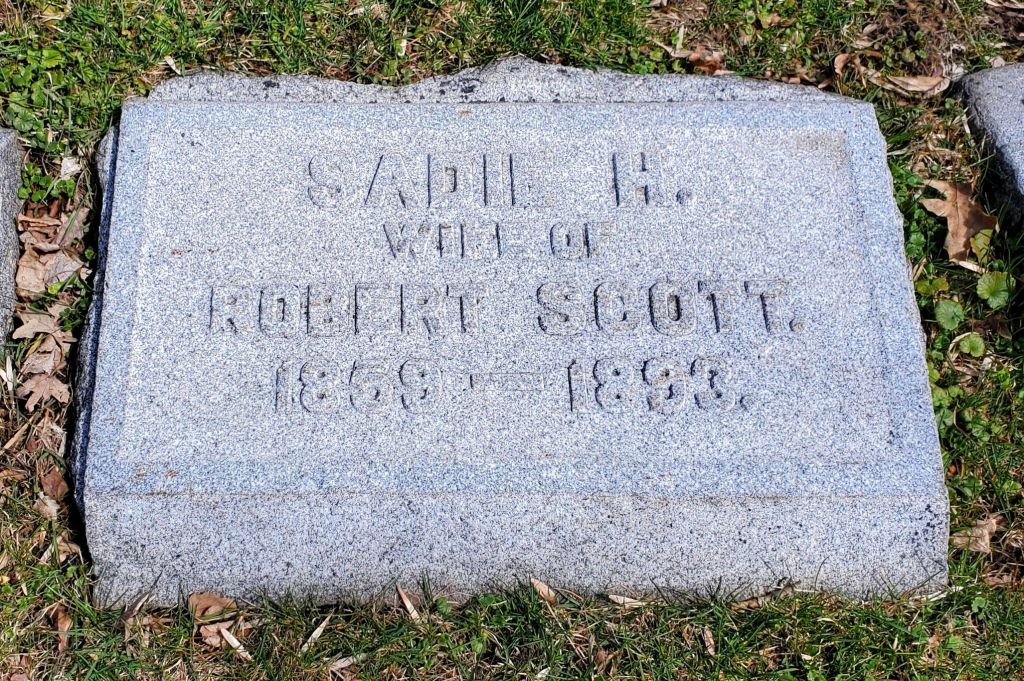
After his wife’s death, Robert SCOTT lived alone with his widowed mother, Elizabeth, for the remainder of the decade. In 1895, they moved together to St. Peter, Nicollet, Minnesota, about an hour south of Minneapolis. St. Peter is the county seat of Nicollet County, Minnesota, and the site of the signing of the Treaty of Traverse des Sioux between the Sioux and the U.S. Government. The breaking of the promises in this treaty is what led directly to the Dakota War of 1862 and bloodshed between the settlers and the Sioux during the 1860s. St. Peter is also the site of the first hospital for the insane in the state – later known as St. Peter State Hospital and now called St. Peter Regional Treatment Center.[23] Elizabeth kept home in a rented apartment at 504 Minnesota Avenue, while Robert worked as a miller.[24]
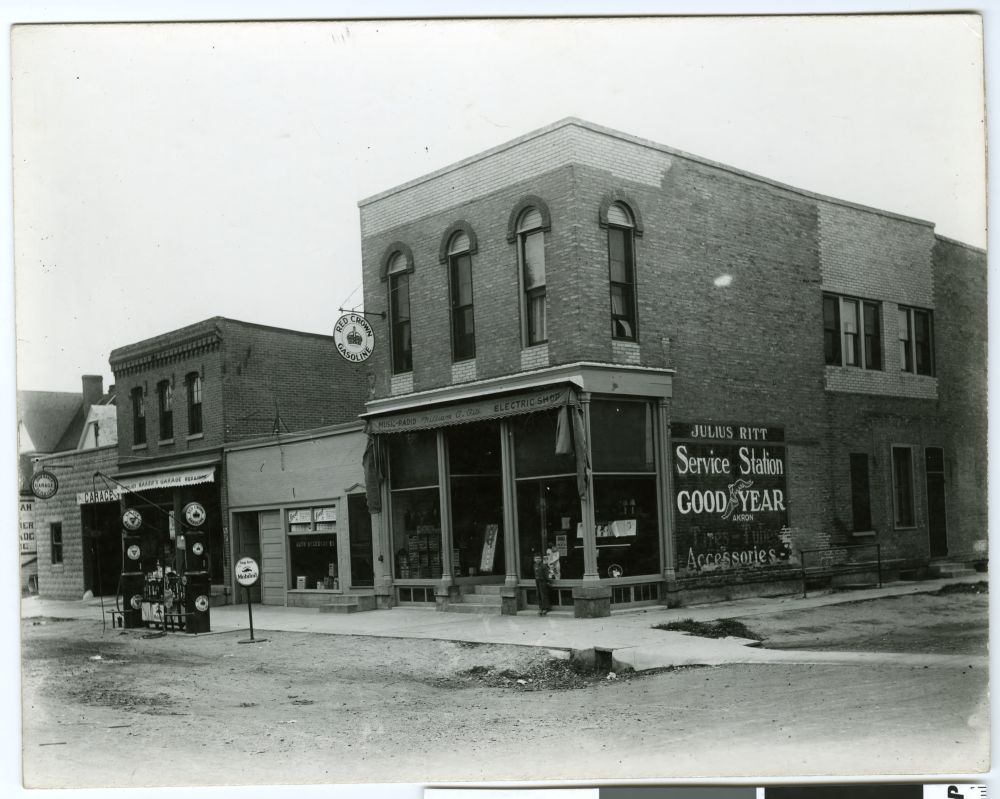
At the turn of the century, Robert married again. This time, he married a woman named Evelyn Maud SNYDER.[25] Evelyn was the daughter of Aaron and Agatha (TEAGLE) SNYDER. She was born in Indiana in 1870, the youngest of sixteen children. Her mother came from a long line of Quakers that had come west from North Carolina in the early 1800s. Evelyn’s father had been married before – his first wife had died young and left him alone to raise a young son. Aaron married Agatha and together they had a large family. Sadly, Aaron SNYDER died when Evelyn was just over a year old. Her mother, Agatha, remarried a man named William LAFLIN when Evelyn was a young girl and the family lived in Wayne County, in east central Indiana on the Ohio border.[26]
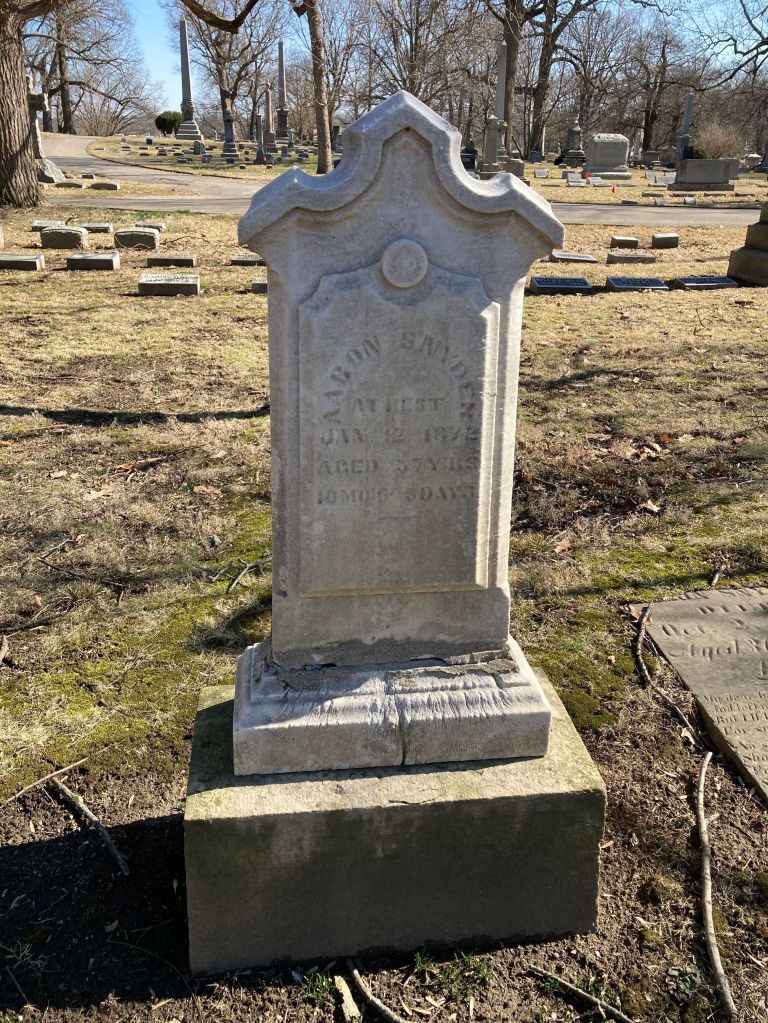
In 1895, Evelyn SNYDER was living in Minneapolis. It is likely she and Robert SCOTT met at this time, after the death of his first wife, and kept in contact when he left the city for Nicollet. When they married in Indianapolis, in September of 1900, Evelyn was around 29 and Robert was nearly 40 years old. The couple returned to the SCOTT home in St. Peter, Nicollet, Minnesota, and within a year they welcomed a daughter, on July 4, 1901, and named her for both of her grandmothers – Elizabeth Agatha SCOTT.[27]
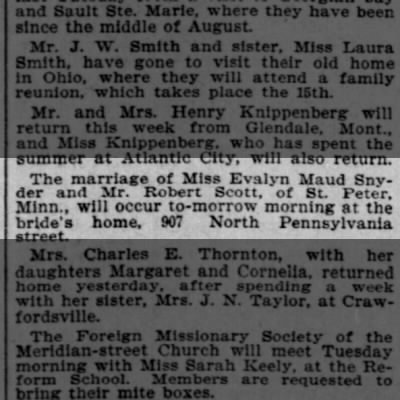
In 1905 the family moved back to the city of Minneapolis. Here Elizabeth MCCLENAGHAN SCOTT died in May of 1906 at the age of 73. She is buried in Lakewood Cemetery.[28] Robert SCOTT, died on February 22, 1910, at the age of 49. He was buried in Lakewood Cemetery alongside his first wife and his mother. His only daughter, Elizabeth, was only 9 years old.
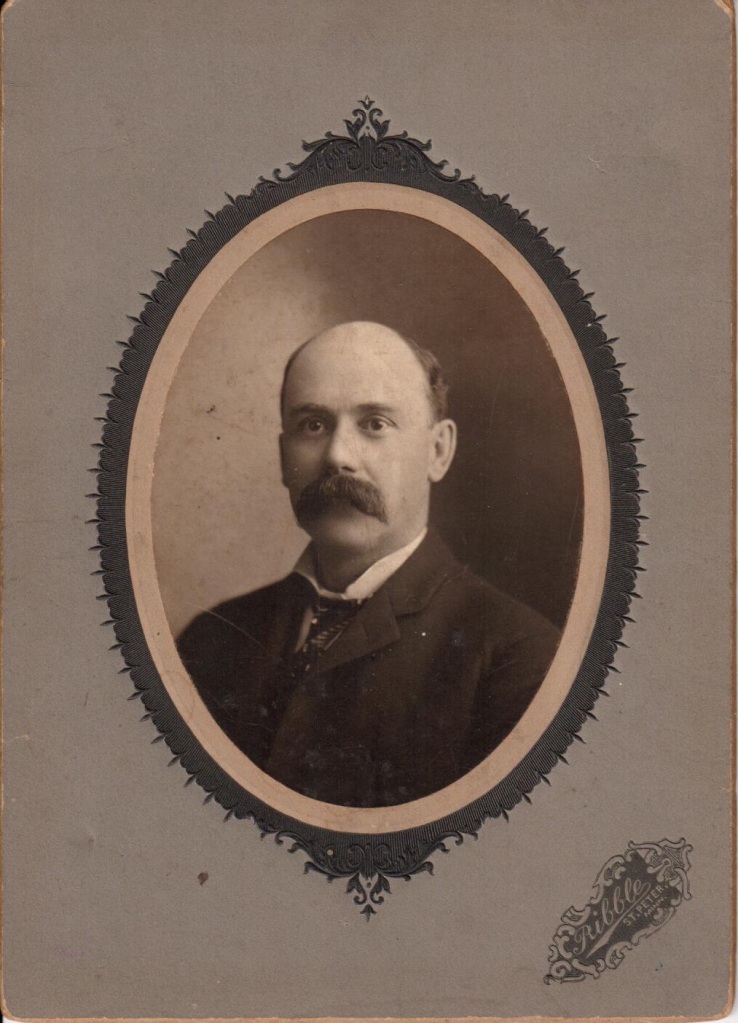
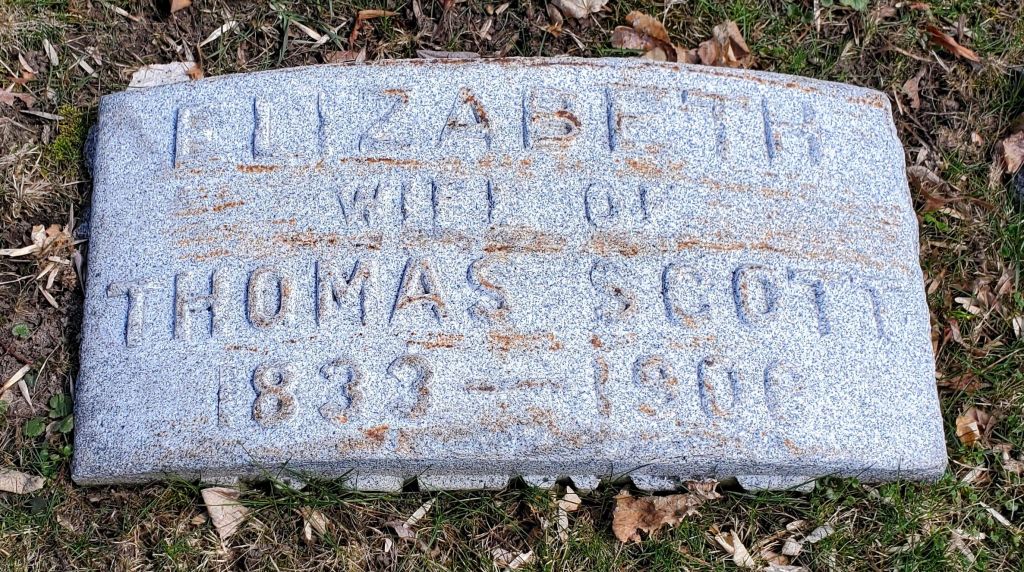

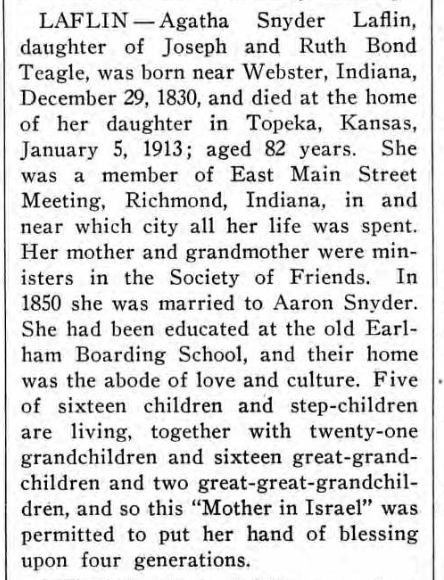
Evelyn’s mother, Agatha TEAGLE SNYDER LAFLIN, died of pneumonia in 1913. In all, five of the SNYDER children would outlive their mother. Although Evelyn SNYDER SCOTT remarried Charles LYNCH in 1915, Elizabeth remained an only child.
In 1919, Elizabeth SCOTT graduated high school. She lived with her mother and stepfather in a newly built multi-family apartment home at 2309 Irving Avenue South in Minneapolis. The building had 5 units and the apartment Elizabeth lived in, number 110, was two stories in the back of the building – the first level contained a living space, bathroom, and bedroom, and the second floor had the kitchen and eating space, and another bedroom and bathroom.

Elizabeth lived on the east side of Lake of the Aisles Park. Just across the park, in the Kenwood section of town, lived Franklin Sherman STONE, Jr., four years Elizabeth’s senior. Franklin had attended the same high school as Elizabeth – he graduated in 1915 so they missed each other by a year. Franklin was the youngest son of Franklin Sherman STONE and Anna (BENSON) STONE. For his story, read Stone Roots in Minnesota: The Franklin Shermans.
Sometime in 1920, Elizabeth’s parents moved the family to 2433 West 22nd Street – next door to the STONE family. Franklin was living at home while he attended the University of Minnesota and studied to become a dentist. In 1923, Elizabeth and Franklin were married. Elizabeth chose her parents wedding anniversary, September 10, as their wedding day and selected the same flowers and colors that her mother had used in her wedding to Robert SCOTT.
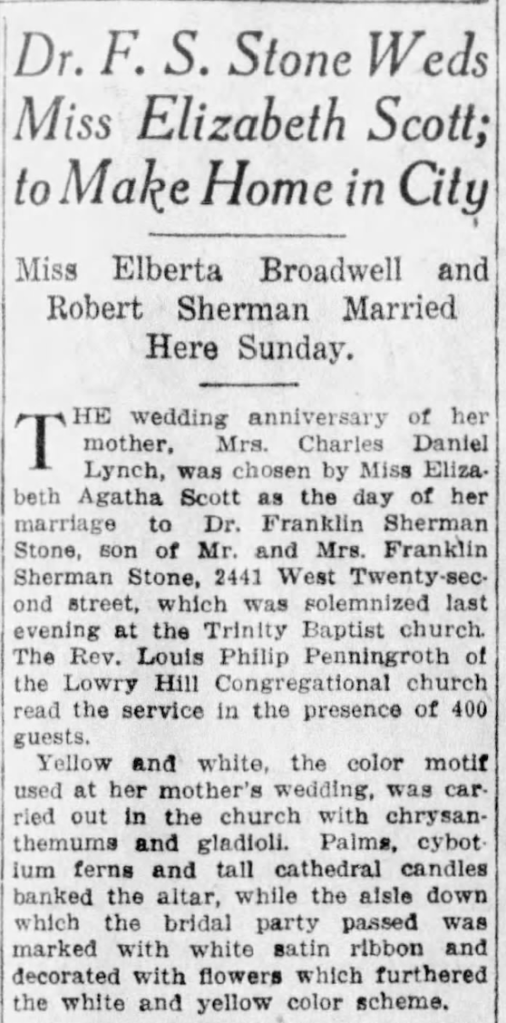

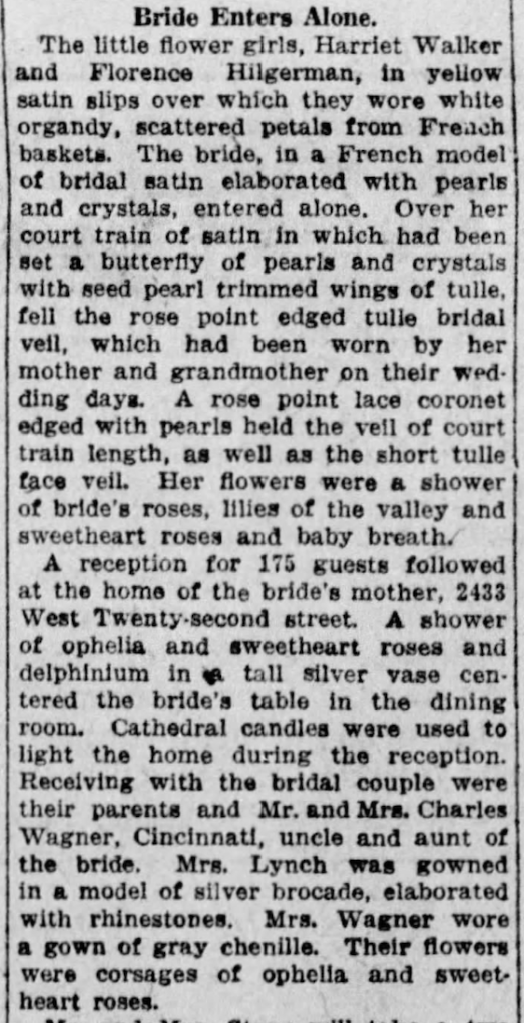
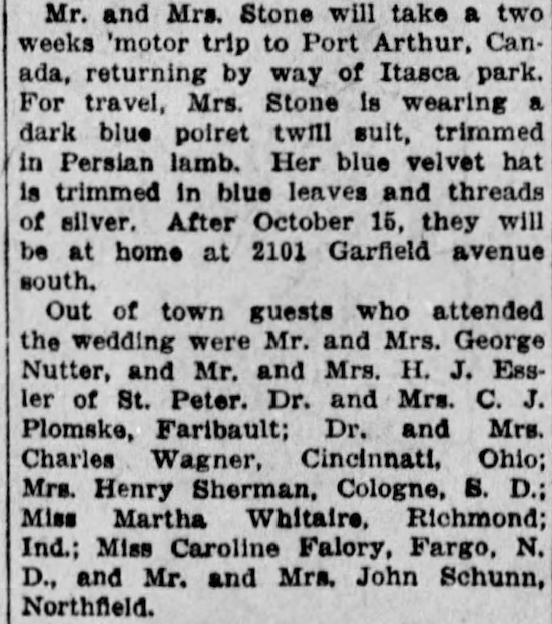
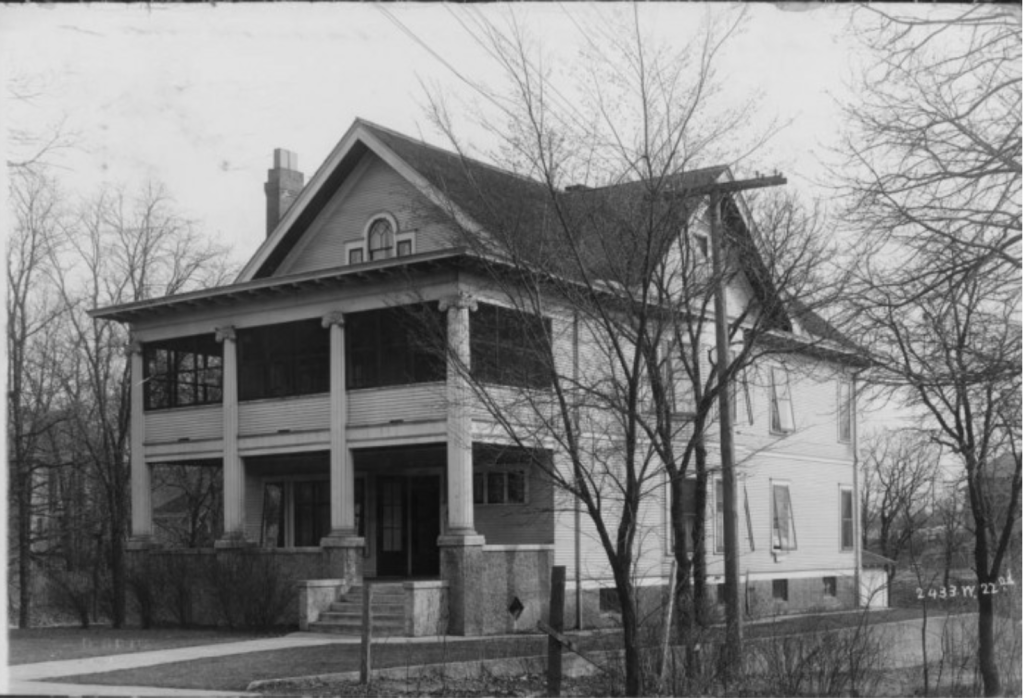
Franklin and Elizabeth began their married life at 2101 Garfield Avenue, Apartment 302 and Franklin started working as a dentist. However, before long they were living back at 2433 West 22nd Street. Here Elizabeth gave birth to a son on August 24, 1924. They named him Robert Scott STONE, after Elizabeth’s father. In April of 1927 they welcomed a daughter, Evelyn Ann, named for both of her grandmothers.
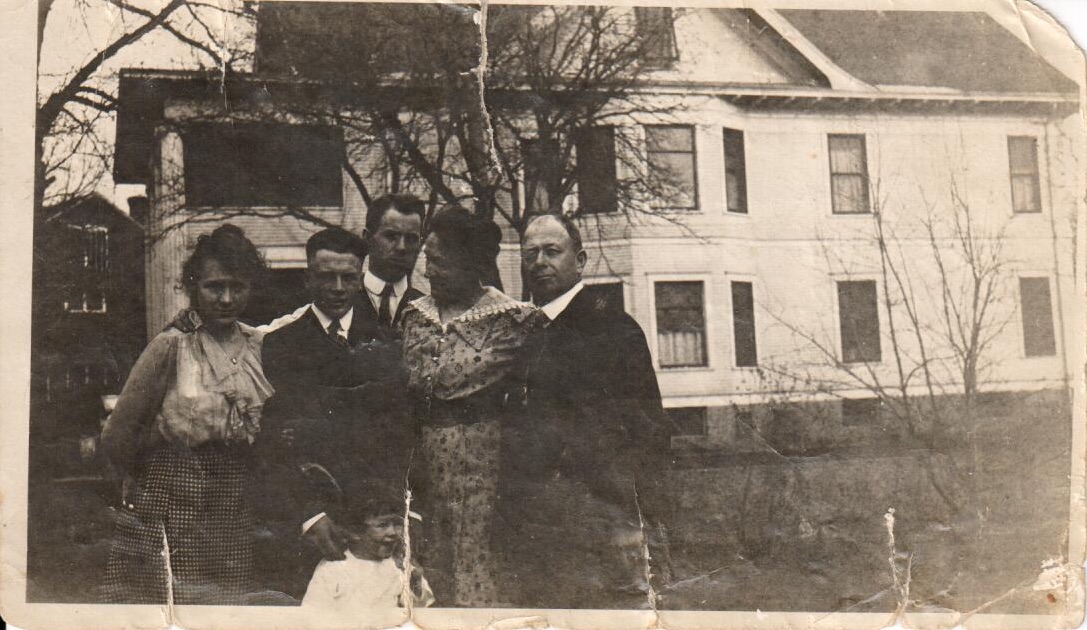
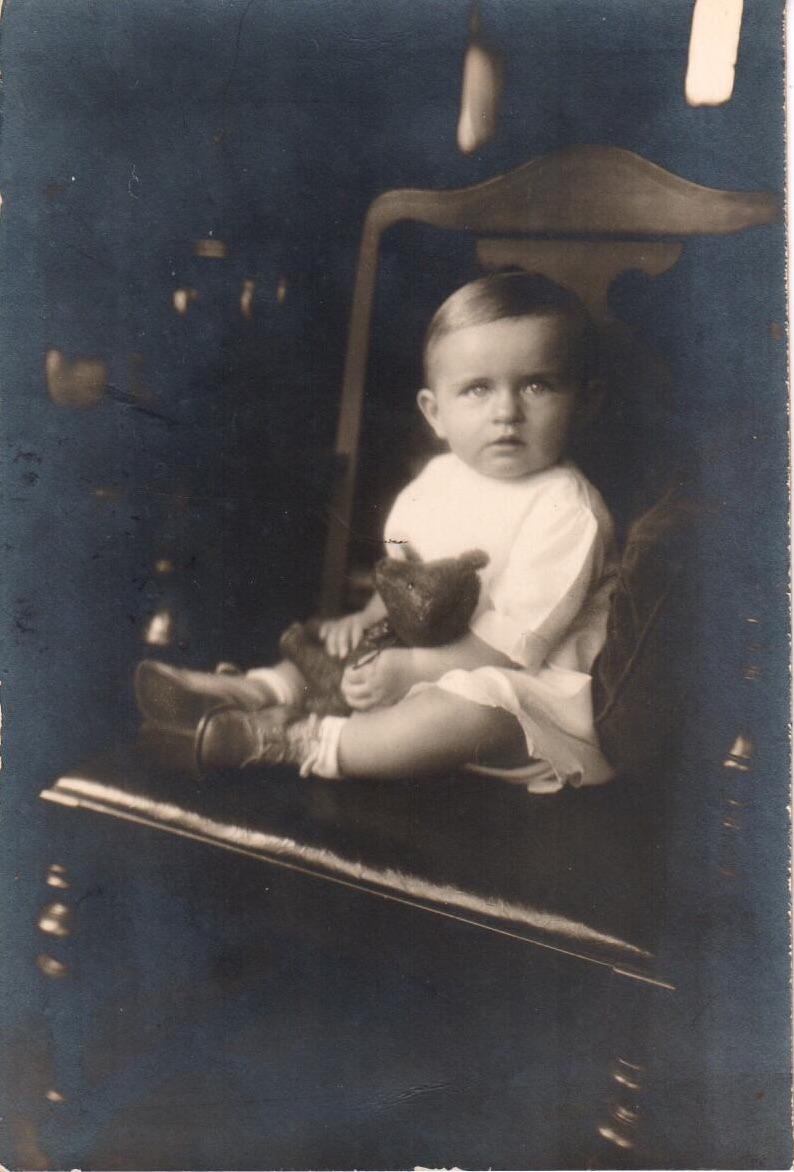

L-R: Elizabeth, Franklin Jr. with Robert Scott, Ellery, Anna C. and Franklin Sr. STONE ca. 1926 in front of 2433 West 22nd Street, Minneapolis; Baby Robert Scott STONE ca. 1925; Robert Scott and Evelyn Ann STONE ca. 1930.
In 1930 the family purchased a home in Fargo, North Dakota at 1316 7th Street. Franklin was working selling fire insurance and managing the office.[29] They lived in North Dakota briefly, but by 1940 the family had returned to Minneapolis and had purchased a home at 4605 York Avenue South. Franklin was promoted to partner and office manager in the insurance office. In February of 1940 the couple had another daughter, Sandra.[30] Sadly, Evelyn Maud SNYDER SCOTT LYNCH died a month later. She was buried alongside her first husband, Robert SCOTT in Lakewood Cemetery.[31]

Robert Scott STONE graduated high school in 1942 and enrolled in the University of Minnesota. In 1946 he graduated from the United States naval Academy; a month later he married Irene “Mikie” MARUDAS. They had three children – two sons and a daughter.
Elizabeth and Franklin and their daughters would move the family out of the city to Glenwood, a small town on Lake Minnewaska, sometime before 1950. Here Franklin worked as a dentist and his eldest daughter, Evelyn, took work as an elementary school teacher before marrying in the summer of 1950 and starting a family of her own.
Evelyn would go on to have 3 sons and 2 daughters and die in 2015.[32]
Franklin STONE Jr. would die of a heart attack on vacation in Texas in 1974. Elizabeth lived until 1985. They are buried together in Lakewood Cemetery.

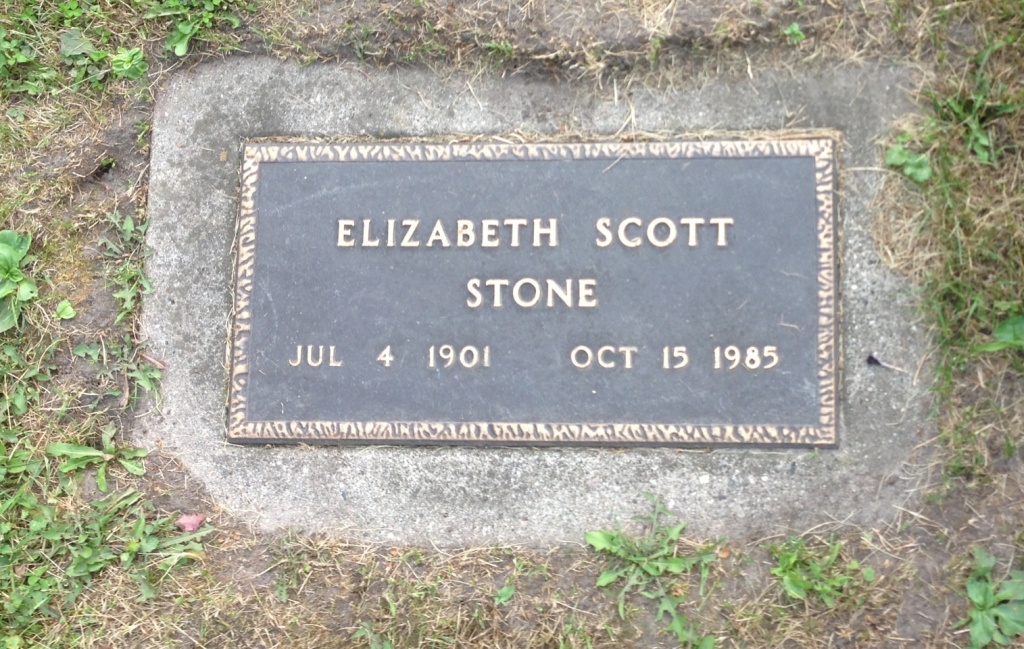
The namesake to Robert SCOTT, the Canadian immigrant who fathered just one daughter before dying young, Robert Scott STONE, would pass the Robert Scott name down for three generations. He was a decorated U.S. Navy Captain, his final post before retirement being as Commanding Officer of the Naval Air Facility in Naples, Italy.[33] He died in November of 2010.
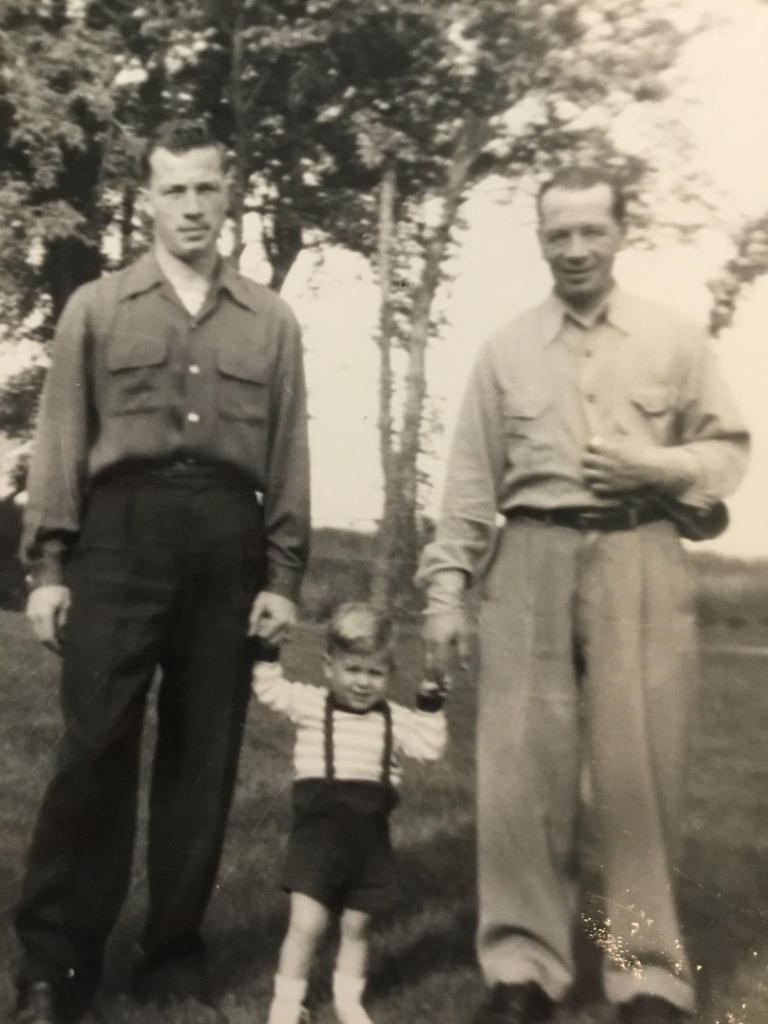

[1] Quebec, Canada, Vital and Church Records (Drouin Collection), 1621-1968; Institut Généalogique Drouin; Montreal, Quebec, Canada; Drouin Collection; Author: Gabriel Drouin, Comp.
[2] https://en.wikipedia.org/wiki/Salaberry-de-Valleyfield
[3] https://www.comeexplorecanada.com/quebec/ormstown
[4] Passenger and Immigration Lists Index, 1500s-1900s; Place: Quebec, Canada; Year: 1847; Page Number: 54
[5] https://globalgenealogy.com/globalgazette/gazrr/gazrr138.htm#:~:text=It%20was%20estimated%20by%20a,1847%20while%20only%2091%2C150%20arrived.&text=From%20England%3A%2032%2C328%20departed%2C%2054%2C329,Scotland%20and%207697%20from%20Germany.&text=Of%20those%20who%20departed%2C%20nearly,of%20every%2010%20would%20die.
[6] https://www.canadashistory.ca/explore/french-canada/montreal-in-time#:~:text=By%201850%2C%20Montr%C3%A9al%20is%20already,inaugurated%3A%20the%20Grand%20Trunk%20Railway.
[7] Canada Census Year: 1851; Census Place: Waterloo, Canada West (Ontario); Schedule: A; Roll: C-11754; Page: 77; Line: 49
[8] iMariages non catholiques de la région de Montréal, 1766-1899/i. Bibliothèque et Archives Nationales du Québec (BAnQ). http://www.banq.qc.ca/archives/genealogie_histoire_familiale/: accessed 24 August 2014.
[9] Institut Généalogique Drouin; Montreal, Quebec, Canada; Drouin Collection; Author: Gabriel Drouin, Comp.
[10] United States of America, Bureau of the Census. Twelfth Census of the United States, 1900. Washington, D.C.: National Archives and Records Administration, 1900. T623, 18
[11] Minnesota State Population Census Schedules, 1865-1905/i. St. Paul, MN, USA: Minnesota Historical Society, 1977. Microfilm. Reels 1-47 and 107-164./liliMinnesota. iMinnesota Territorial Census Schedules, 1849-1855
[12]
https://www.findagrave.com/memorial/169900081/thomas-scott
[13] Census of Canada Year: 1901; Census Place: Hope, Durham (East/Est), Ontario; Page: 7; Family No: 71
[14] Canada Census Year: 1891; Census Place: York West, York West, Ontario, Canada; Roll: T-6381; Family No: 152
[15] Year: 1901; Census Place: Toronto (West/Ouest) (City/Cité) Ward/Quartier No 4, Toronto (West/Ouest) (City/Cité), Ontario; Page: 16; Family No: 117
[16] Year: 1911; Census Place: 65 – Ward six, Toronto South, Ontario; Page: 19; Family No: 147
[17] https://www.mnhs.org/millcity/learn/history/flour-milling
[18] https://www.cynthiafroid.com/downtown-digest/neighborhood-spotlight-mill-district
[19] U.S. Federal Census Year: 1880; Census Place: Des Moines, Polk, Iowa; Roll: 360; Page: 346B; Enumeration District: 163; Newspapers.com – The Des Moines Register – 25 Oct 1879 – Page 3
[20][20] Minnesota Historical Society. Minnesota State Population Census Schedules, 1865-1905. St. Paul, MN, USA: Minnesota Historical Society, 1977. Microfilm. Reels 1-47 and 10; Reels 1-47 and 107-164
[21] Minnesota, U.S., Marriages from the Minnesota Official Marriage System, 1850-2022; Certificate Number 560365; https://moms.mn.gov/
[22]
https://www.findagrave.com/memorial/128236016/sadie-h-scott
[23] https://en.wikipedia.org/wiki/St._Peter,_Minnesota
[24] Minnesota Historical Society. Minnesota State Population Census Schedules, 1865-1905. St. Paul, MN, USA: Minnesota Historical Society, 1977. Microfilm. Reels 1-47 and 10
[25] Indiana, Select Marriages Index, 1748-1993; Film number 499381
[26] U.S. Federal Census; Year: 1880; Census Place: Richmond, Wayne, Indiana; Page: 41; Enumeration District: 73; Dwelling: 401; Family: 405.
[27] Web: Minnesota, Birth Index, 1900-1934; Social Security Death Index: Number: XXX-XX-8826; Issue State: Minnesota; Issue Date: Before 1951.
[28]
https://www.findagrave.com/memorial/128203785/elizabeth-scott
[29] Fifteenth Census of the United States, 1930. Washington, D.C.: National Archives and Records Administration, 1930. T626 Residence place: Fargo, Cass, North Dakota; Sheet: 61B
[30] Sixteenth Census of the United States, 1940. Washington, D.C.: National Archives and Records Administration, 1940. T627
[31] The Minneapolis Star; Publication Date: 18 Mar 1940; Publication Place: Minneapolis, Minnesota, USA
[32] National Archives at Washington, DC; Washington, D.C.; Seventeenth Census of the United States, 1950; Year: 1950; Census Place: Glenwood, Pope, Minnesota; Roll: 261; Page: 8; Enumeration District: 61-13
[33] https://militaryhallofhonor.com/honoree-record.php?id=210518
One response to “Scottish Canadians in the American Midwest – The Scotts”
[…] This article tells of how the STONE line connects with the SCOTT line. To read about the history of the STONE family, see our story Homesteaders: The Stone Line in the 19th Century. For the story of the SCOTTs and where they came from, see our story Scottish Canadians in the American Midwest – The Scotts. […]